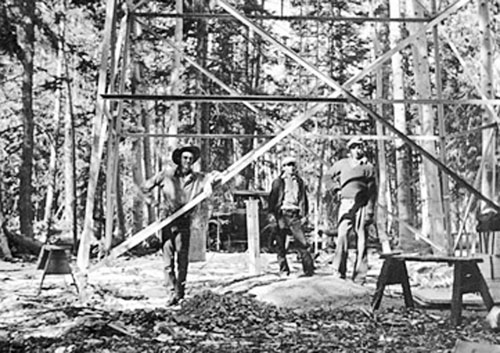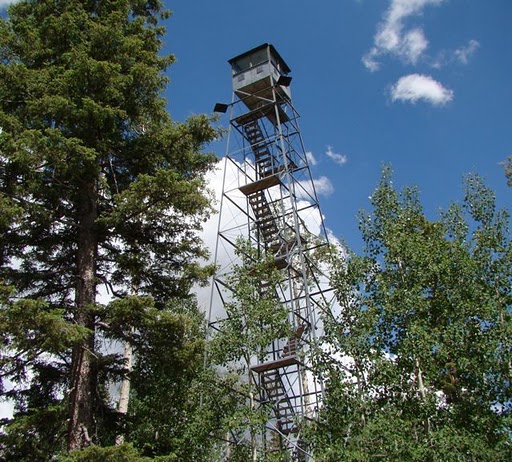At the beginning of the 20th Century, federal administrators of the Grand Canyon region were involved in an ongoing war against what they viewed as a destructive force: fire. One of their main weapons in preventing fires were a network of fire towers built throughout the Grand Canyon.
Before Grand Canyon was designated a national park in 1919, the US Forest Service administered most of the Canyon. This agency was especially vigorous in its prosecution of the war against fire. It constructed wooden lookout platforms at Bright Angel Point on the North Rim and Hopi Point and Grandview Point on the South Rim. The National Park Service improved this early lookout system by replacing the wooden platforms with steel frame towers at Bright Angel Point and Hopi Point, and by building the Signal Hill and Kanabownits towers. The NPS improved emergency communications by installing new phones in the towers and establishing a central dispatch at Grand Canyon Village during the 1920s.
A 75-foot-tall Aermotor tower with cab was built at Bright Angel Point in 1928. Five years later Civilian Conservation Corps crews moved it to its current location at the north entrance to the park, at which time it became known as the North Rim Lookout. The CCC also built many tree towers on the North and South Rims in the mid-1930s to supplement the work done by spotters at the Bright Angel fire tower and others.
The NPS continued to use many of these towers and outlooks, including the Bright Angel fire tower, into the 1970s. And the work that these lookouts did was highly efficient: fires rarely burned more than one hundred acres in the park each year while the park operated under a philosophy of fire suppression.

Noted environmentalist and novelist Edward Abbey spent several summers manning the fire tower at Bright Angel Point, an experience that informed his writing.
Photo: Edward Abbey
Famed environmentalist and author Edward Abbey worked for four seasons at the Bright Angel fire tower as a lookout. His experiences inspired his novel Black Sun about a man who worked on a remote fire lookout on the Nort
h Rim of the Grand Canyon and is blamed for his girlfriend’s disappearance. He also included a chapter in his collection of essays titled Abbey’s Road about his summers as a lookout. As he described it: “One entered through a trap door in the bottom. Inside was the fire finder—an azimuth and sighting device—fixed to a cabinet bolted to the floor. There was a high swivel chair with glass insulators, like those on a telephone line, mounted on the lower tips of the chair’s four legs. In case of lightning. It was known as the electric chair” (Abbey, 1979: 177). Abbey found it to be tedious work, but an excellent
environment for stimulating a writer’s imagination.
In the early 1970s, the NPS stopped actively manning fire towers and instead relied solely on aerial reporting. It also moved away from fire suppression in favor of prescribed burns and managed wildfires to help re-establish the essential role of fire in the ecological health of the landscape.
In 2009, four historic fire lookout towers in Grand Canyon National Park, including the Bright Angel (North Rim) fire tower, were listed on the National Historic Lookout Register. This register is a cooperative effort of the Forest Fire Lookout Association, the National Forestry Association, the National Woodland Owners Association, the U.S. Forest Service,state forestry departments and Department of Interior agencies.
It is intended to identify historic lookout towers that have played an important function in forest conservation. The Bright Angel fire tower has certainly been a significant site in both the natural and cultural history of the Grand Canyon.
Written By Sarah Bohl Gerke
Suggested Reading:
- Anderson, Michael F. Living at the Edge: Explorers, Exploiters and Settlers of the Grand Canyon Region. Grand Canyon Association, 1998.
- Anderson, Michael. Polishing the Jewel: An Administrative History of Grand Canyon National Park. Grand Canyon Association, 2000.


